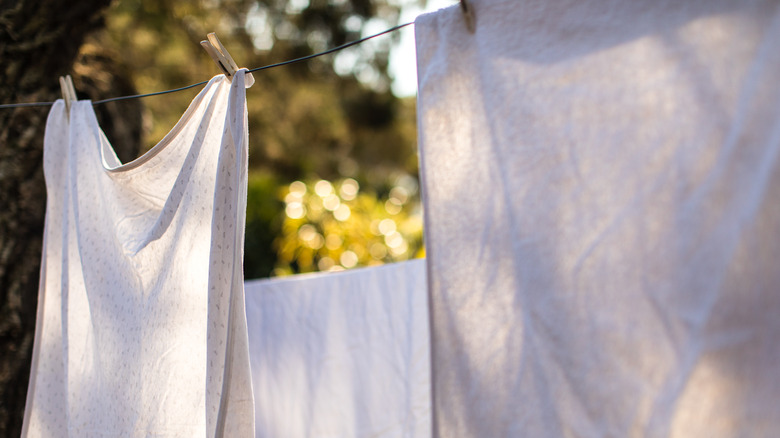Does Linen Shrink In The Dryer? (And Other Important Care Information To Know)
Linen is natural, breathable, and durable, making it a wonderful fabric for bedding and clothing, especially in the summer. However, it's not the lowest-maintenance fabric out there, as it requires the right care to stay in good shape. Similar to wool, it's among the most likely fabrics to shrink in the laundry. Not only can linen items shrink in the dryer, but they can also shrink in the washing machine.
Some initial shrinkage is inevitable with many linen items, which can shrink up to 3 to 4% the first time they are washed. To avoid this, you can shop for pre-washed linen only. Otherwise, you'll want to account for that change in size when shopping for linen, and consider sizing up a bit.
After that, further shrinking up to 10% can occur with any exposure to high heat and moisture, whether in the washer or dryer. Linen is made by turning the fibers of the flax plant into yarn, which is then woven into fabric. Moisture and heat cause these fibers to contract, which shrinks the fabric as a whole. It's hard to undo shrinkage, so prevention is the best approach. You may also prefer opting for a different fabric that's less likely to shrink in the wash.
How to wash and dry linen properly
Each time you wash linen, it gets a bit softer. The care instructions on your linen items will give specific guidance on washing and drying. In general, for washing, your two options are to hand-wash or use a washing machine on the gentle or delicate setting. Either way, work with cold or lukewarm water and a mild detergent, and do not use bleach.
Some linen pieces can go in the dryer, while others need to be air-dried. If you use the dryer, go with a low or medium heat setting, remove the linen while it's still damp, and allow it to air-dry the rest of the way. When in doubt, skipping the dryer altogether is a safe bet. While it takes a bit longer, linen air-dries relatively quickly, and this method helps prevent shrinkage. Just hang your items or lay them flat to dry. Place them outside of direct sunlight, which may fade or discolor the fabric over time.
Keep your linen items separate from your other laundry to prevent fuzzing. Make sure they have plenty of room in the washer and dryer (or the sink or tub if hand-washing). Twisting or tugging on the material is another contributor to shrinkage and can also damage the fibers. You can also bring your linen to the dry cleaner.
How to avoid wrinkles and treat stains
One downside of linen is that it's prone to wrinkles. Some people are fine with or even prefer a slightly wrinkled look, but there are several prevention methods if you're not a fan. First, you can stretch and smooth the linen by hand before laying it flat to dry. For an even smoother look, iron the linen on the lowest heat setting while it's still slightly damp from the wash. Shortening the spin cycle on the washing machine may also prevent as many wrinkles from forming.
Ironing your linen is also a method to undo some shrinkage. After washing, hang the item to dry until it's no longer dripping wet. Then, iron it on the lowest setting, working from the center outward. This helps re-stretch the fibers that have contracted.
If you spill something on your linen, spot treat it as soon as possible. Gently blot (don't rub) the stain with a clean, dry cloth. Depending on the stain, pre-treatment with a mild detergent, white vinegar, or dish soap before washing as usual can also help. Just make sure the stain is gone before you dry it in a dryer, as it may set permanently.


